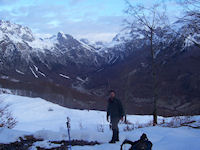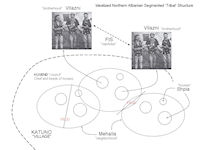

Figure 9: Photo of Shala in winter, from west looking northeast into Theth (Galaty).
Figure 10: Map of northern Albanian tribal structure (Galaty).
Life in the high mountains of Albania is difficult. While the peaks of Shala approach 3000 masl, most houses are at valley bottom, between 800 and 1000 masl. The climate is sub-Alpine and the winters are long and hard, with large amounts of snow (Fig. 9; in January of 2008, SVP members Michael Galaty, Wayne Lee, and Zamir Tafilica traveled to Theth by snowshoe. An account of this trip is available at http://millsaps.edu/news_events/blog/galaty.shtml). The economy is currently built around full-time sedentary agro-pastoralism - sometimes called 'mixed' village farming - and functions at or just below subsistence levels; government aid or remittances from relatives overseas bridge the gap. Settled agro-pastoralism and tribal socio-political organisation together have had a profound effect on Shala's landscape and built environment. Large, stone houses, some of them semi-fortified, called kulla, dot elaborately terraced foothills. Property boundaries are marked by stone walls and fences, and deeply entrenched, clearly very old paths, called shtegu, link fields and homes.


Figure 9: Photo of Shala in winter, from west looking northeast into Theth (Galaty).
Figure 10: Map of northern Albanian tribal structure (Galaty).
The tribal socio-political system can be described as follows (Fig. 10): Large extended households (shpia) organised into neighbourhoods (mehalla) share patrilineal descent from a common apical ancestor, thereby forming exogamous segmented clans or 'tribes' (fisi) [View Comments] (see Parkinson 2002 for a thorough discussion of the term 'tribe' and its meaning). Individual fisi may be further divided into 'brotherhoods' (vllazni). Several neighbourhoods and fisi together compose a single village (katund). Political power is vested in the person of the family patriarch, the zot i shpi. Family heads are appointed or elected to a village council, a kuvend, that makes decisions of importance to the whole community. A single council member is elected 'headman' or kryeplak. In Ottoman times, several villages and fisi might be politically joined in a bajrak, a 'banner', led by a bajraktar, a 'banner chief'. Oral, customary laws regarding kinship relations and political organisation were codified by a 15th-century chief named Lekë Dukagjini. The Kanuni i Lekë Dukagjinit was not transcribed in full until the early 20th century by a Franciscan priest, Father Shtjefën Gjeçov (Gjeçov 1989; audio clip #2). The kanun is based on the concept of honour (nder). Any breach of a man's honour might precipitate a blood feud (gjakmarrje).
| In this article, we define 'tribe' in the traditional anthropological sense of a lineage-based egalitarian or trans-egalitarian, segmentary socio-political formation. The term is, however, not without its detractors. We would welcome discussion from readers regarding its utility. | Michael Galaty |
© Internet Archaeology/Author(s)
URL: http://intarch.ac.uk/journal/issue27/1/3.cfm
Last updated: Thu Feb 25 2010